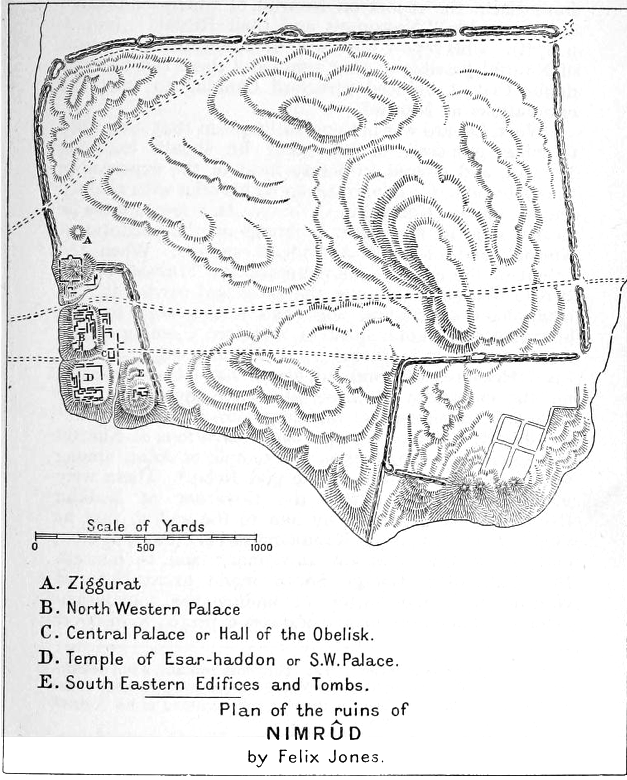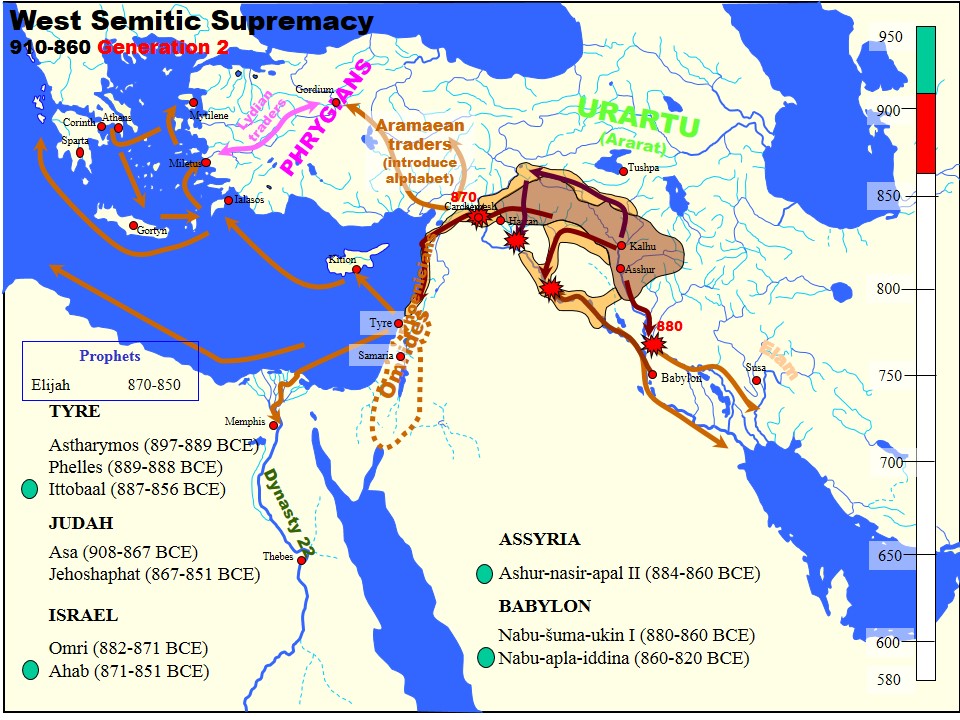|
Kalhu
Nimrud (; ) is an ancient Assyrian city (original Assyrian name Kalḫu, biblical name Calah) located in Iraq, south of the city of Mosul, and south of the village of Selamiyah (), in the Nineveh Plains in Upper Mesopotamia. It was a major Assyrian city between approximately 1350 BC and 610 BC. The city is located in a strategic position north of the point that the river Tigris meets its tributary the Great Zab.Brill's Encyclopedia of Islam 1913-36 p.923 The city covered an area of . The ruins of the city were found within of the modern-day Assyrian village of Noomanea in [...More Info...] [...Related Items...] OR: [Wikipedia] [Google] [Baidu] |
Ashurnasirpal II
Ashur-nasir-pal II (transliteration: ''Aššur-nāṣir-apli'', meaning " Ashur is guardian of the heir") was the third king of the Neo-Assyrian Empire from 883 to 859 BC. Ashurnasirpal II succeeded his father, Tukulti-Ninurta II. His son and successor was Shalmaneser III and his queen was Mullissu-mukannišat-Ninua. Reign During his reign he embarked on a vast program of expansion, first conquering the peoples to the north in Asia Minor as far as Nairi and exacting tribute from Phrygia, then invading Aram (modern Syria) conquering the Aramaeans and Neo-Hittites between the Khabur and the Euphrates Rivers. The palaces, temples and other buildings raised by him bear witness to a considerable development of wealth and art. Cruelty Ashurnasirpal II was notorious for his brutality, using enslaved captives to build a new Assyrian capital at Kalhu (Nimrud) in Mesopotamia where he built many impressive monuments. He was also a shrewd administrator, who realized that he could gain ... [...More Info...] [...Related Items...] OR: [Wikipedia] [Google] [Baidu] |
Assur
Aššur (; AN.ŠAR2KI, Assyrian cuneiform: ''Aš-šurKI'', "City of God Aššur"; ''Āšūr''; ''Aθur'', ''Āšūr''; ', ), also known as Ashur and Qal'at Sherqat, was the capital of the Old Assyrian city-state (2025–1364 BC), the Middle Assyrian Empire (1363–912 BC), and for a time, of the Neo-Assyrian Empire (911–609 BC). The remains of the city lie on the western bank of the Tigris River, north of the confluence with its tributary, the Little Zab, in what is now Iraq, more precisely in the al-Shirqat District of the Saladin Governorate. Occupation of the city itself continued for approximately 3,000 years, from the Early Dynastic Period to the mid-3rd century AD, when the city was sacked by the Sasanian Empire. The site is a World Heritage Site and was added to that organisation's list of sites in danger in 2003 as a result of a proposed dam, which would flood some of the site. It has been further threatened by the conflict that erupted following the US-led ... [...More Info...] [...Related Items...] OR: [Wikipedia] [Google] [Baidu] |
Nimrod
Nimrod is a Hebrew Bible, biblical figure mentioned in the Book of Genesis and Books of Chronicles, the Books of Chronicles. The son of Cush (Bible), Cush and therefore the great-grandson of Noah, Nimrod was described as a king in the land of Shinar (Lower Mesopotamia). The Bible states that he was "a mighty hunter before the Lord [and] ... began to be mighty in the earth". Biblical and non-biblical traditions identify Nimrod as the ruler who had commissioned the construction of the Tower of Babel, and that identification led to his reputation as a king who had been rebellious against God. There is no direct evidence that Nimrod was an actual historical person in any of the non-biblical historic records, registers, or king lists (including any of the Mesopotamian ones, which are considered older than the biblical record). Historians have failed to match Nimrod with any real historically attested figure, or to find any historical, linguistic or genetic link between the Sumer, Sume ... [...More Info...] [...Related Items...] OR: [Wikipedia] [Google] [Baidu] |
Shalmaneser III
Shalmaneser III (''Šulmānu-ašarēdu'', "the god Shulmanu is pre-eminent") was king of the Neo-Assyrian Empire from 859 BC to 824 BC. His long reign was a constant series of campaigns against the eastern tribes, the Babylonians, the nations of Mesopotamia, Syria, as well as Kizzuwadna and Urartu. His armies penetrated to Lake Van and the Taurus Mountains; the Neo-Hittites of Carchemish were compelled to pay tribute, and the kingdoms of Hamath and Aram Damascus were subdued. It is in the annals of Shalmaneser III from the 850s BC that the Arab people, Arabs and Chaldeans first appear in recorded history. Reign Campaigns Shalmaneser began a campaign against Urartu and reported that in 858 BCE, he destroyed the city of Sugunia, and then in 853 BCE Araškun. Both cities are assumed to have been capitals of Urartu before Tushpa became a center for the Urartians. In 853 BC, a coalition was formed by eleven states, mainly by Hadadezer, King of Aram-Damascus; Irhuleni, king of Hama ... [...More Info...] [...Related Items...] OR: [Wikipedia] [Google] [Baidu] |
Mosul
Mosul ( ; , , ; ; ; ) is a major city in northern Iraq, serving as the capital of Nineveh Governorate. It is the second largest city in Iraq overall after the capital Baghdad. Situated on the banks of Tigris, the city encloses the ruins of the ancient Old Assyrian Empire, Assyrian city of Nineveh—once the List of largest cities throughout history, largest city in the world—on its east side. Due to its strategic and central location, the city has traditionally served as one of the hubs of international commerce and travel in the region. It is considered as one of the historically and culturally significant cities of the Arab world. The North Mesopotamian dialect of Arabic commonly known as North Mesopotamian Arabic, ''Moslawi'' is named after Mosul, and is widely spoken in the region. Together, with the Nineveh Plains, Mosul is a historical center of the Assyrian people, Assyrians. The surrounding region is ethnically and religiously diverse; a large majority of the city is A ... [...More Info...] [...Related Items...] OR: [Wikipedia] [Google] [Baidu] |
Mesopotamia
Mesopotamia is a historical region of West Asia situated within the Tigris–Euphrates river system, in the northern part of the Fertile Crescent. Today, Mesopotamia is known as present-day Iraq and forms the eastern geographic boundary of the modern Middle East. Just beyond it lies southwestern Iran, where the region transitions into the Iranian plateau, Persian plateau, marking the shift from the Arab world to Iran. In the broader sense, the historical region of Mesopotamia also includes parts of present-day Iran (southwest), Turkey (southeast), Syria (northeast), and Kuwait. Mesopotamia is the site of the earliest developments of the Neolithic Revolution from around 10,000 BC. It has been identified as having "inspired some of the most important developments in human history, including the invention of the wheel, the planting of the first cereal crops, the development of cursive script, mathematics, astronomy, and agriculture". It is recognised as the cradle of some of t ... [...More Info...] [...Related Items...] OR: [Wikipedia] [Google] [Baidu] |
Assyrian People
Assyrians (, ) are an ethnic group Indigenous peoples, indigenous to Mesopotamia, a geographical region in West Asia. Modern Assyrians Assyrian continuity, share descent directly from the ancient Assyrians, one of the key civilizations of Mesopotamia. While they are distinct from other Mesopotamian groups, such as the Babylonians, they share in the broader cultural heritage of the Mesopotamian region. Modern Assyrians may culturally self-identify as Terms for Syriac Christians#Syriac identity, Syriacs, Chaldean Catholics, Chaldeans, or Terms for Syriac Christians#Aramean identity, Arameans for religious, geographic, and tribal identification. Assyrians speak various dialects of Neo-Aramaic, specifically those known as Suret and Turoyo, which are among the oldest continuously spoken and written languages in the world. Aramaic was the lingua franca of West Asia for centuries and was the language spoken by historical Jesus, Jesus. It has influenced other languages such as Hebrew an ... [...More Info...] [...Related Items...] OR: [Wikipedia] [Google] [Baidu] |
Shalmaneser I
Shalmaneser I (𒁹𒀭𒁲𒈠𒉡𒊕 md''sál-ma-nu-SAG'' ''Salmanu-ašared''; 1273–1244 BC or 1265–1235 BC) was a king of Assyria during the Middle Assyrian Empire. He was the son and successor of Adad-nirari I. Reign Year 1: According to his annals, discovered at Assur, in his first year he conquered eight countries in the northwest and destroyed the fortress of Arinnu, the dust of which he brought to Assur. Year 2: In his second year he defeated Shattuara, king of Hanilgalbat (Mitanni), and his Hittite and Ahlamu allies. He incorporated the remains of the Mittanni kingdom as part of one of the Assyrian provinces. Shalmaneser I also claimed to have blinded 14,400 enemy prisoners in one eye. He was one of the first Assyrian kings who was known to deport his defeated enemies to various lands rather than simply slaughtering them all. He conquered the whole country from Taidu to Irridu, from Mount Kashiar to Eluhat, and from the fortresses of Sudu and Harranu to ... [...More Info...] [...Related Items...] OR: [Wikipedia] [Google] [Baidu] |
Lamassu
''Lama'', ''Lamma'', or ''Lamassu'' (Cuneiform: , ; Sumerian language, Sumerian: lammař; later in Akkadian language, Akkadian: ''lamassu''; sometimes called a ''lamassuse'') is an Mesopotamia, Assyrian protective deity. Initially depicted as a goddess in Sumerian times, when it was called ''Lamma'', it was later depicted from Assyrian times as a hybrid of a human, bird, and either a bull or lion—specifically having a human head, the body of a bull or a lion, and bird wings, under the name ''Lamassu''. In some writings, it is portrayed to represent a goddess. A less frequently used name is ''shedu'' (Cuneiform: , ; Sumerian: alad; Akkadian, ''šēdu''), which refers to the male counterpart of a ''lamassu''. ''Lamassu'' represent the zodiacs, parent-stars or constellations. Goddess Lama The goddess Lama appears initially as a mediating goddess who precedes the orans and presents them to the deities. The protective deity is clearly labelled as Lam(m)a in a Kassites, Kassite st ... [...More Info...] [...Related Items...] OR: [Wikipedia] [Google] [Baidu] |
Business Insider
''Business Insider'' (stylized in all caps: BUSINESS INSIDER; known from 2021 to 2023 as INSIDER) is a New York City–based multinational financial and business news website founded in 2007. Since 2015, a majority stake in ''Business Insider''s parent company Insider Inc. has been owned by the international publishing house Axel Springer. It operates several international editions, including one in the United Kingdom. ''Insider'' publishes original reporting and aggregates material from other outlets. it maintained a liberal policy on the use of anonymous sources. It has also published native advertising and granted sponsors editorial control of its content. The outlet has been nominated for several awards, but has also been criticized for using factually incorrect clickbait headlines to attract viewership. In 2015, Axel Springer SE acquired 88 percent of the stake in Insider Inc. for $343 million (€306 million), implying a total valuation of $442 million. From ... [...More Info...] [...Related Items...] OR: [Wikipedia] [Google] [Baidu] |
Stela
A stele ( ) or stela ( )The plural in English is sometimes stelai ( ) based on direct transliteration of the Greek, sometimes stelae or stelæ ( ) based on the inflection of Greek nouns in Latin, and sometimes anglicized to steles ( ) or stelas ( ). is a stone or wooden slab, generally taller than it is wide, erected in the ancient world as a monument. The surface of the stele often has text, ornamentation, or both. These may be inscribed, carved in relief, or painted. Stelae were created for many reasons. Grave stelae were used for funerary or commemorative purposes. Stelae as slabs of stone would also be used as ancient Greek and Roman government notices or as boundary markers to mark borders or property lines. Stelae were occasionally erected as memorials to battles. For example, along with other memorials, there are more than half-a-dozen steles erected on the battlefield of Waterloo at the locations of notable actions by participants in battle. A traditional Wester ... [...More Info...] [...Related Items...] OR: [Wikipedia] [Google] [Baidu] |









